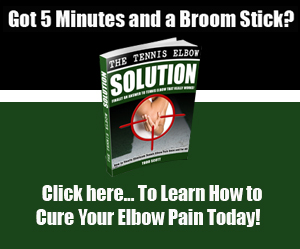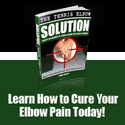Tennis elbow, or lateral epicondylitis, is a common elbow injury of racket sport players and manual laborers. Tennis elbow is an overuse injury resulting from the performance of repetitive motions with the hand and forearm, such as swinging a tennis racket or a hammer. Such repetitive motions can cause inflammation of the muscles of the forearm. The symptoms of tennis elbow include pain, soreness, and weakness in the muscles on the outside of the forearm. The treatment of tennis elbow is usually conservative, relying on rest, ice, and anti-inflammatory medication.
When attempting to diagnosis tennis elbow, a doctor or physical therapist will test for tenderness on or near the bony knob of the elbow joint. Pain that increases when bending the wrist back is also indicative of tennis elbow. Tennis elbow related pain also increases when gripping. Thus, shaking hands may be painful. Finally, a perception of weakness or chronic muscle fatigue in the forearm muscles is an indicator of tennis elbow.
Treatment for tennis elbow is usually conservative and passive. Most importantly, people with tennis elbow should avoid the activities that cause forearm pain (e.g., playing tennis) until the injury heals. Rest will often correct tennis elbow in a matter of weeks. In addition, the use of ice and anti-inflammatory medications can ease pain and promote healing. Physical therapy and heat therapy may also hasten the healing process. Finally, upon returning to regular activity, wearing an elbow and forearm brace can prevent recurrence of tennis elbow. Elbow braces, available at drug stores, help prevent tennis elbow by restricting movement and use of the elbow.
Because treatment of tennis elbow and recovery from tennis elbow can be a long, frustrating process, prevention is the best strategy. For tennis players, several equipment adjustments can help prevent tennis elbow. Players should select a racket with a midsized racket head (90 – 105 square inches) and high flexibility (stiffness index lower than 65). Additionally, players should string their rackets with soft strings such as synthetic nylon or natural gut at the low end of the recommended tension range. Finally, to prevent tennis elbow, players should ensure that the grip of their racket is neither too large nor too small.
Besides equipment adjustments, tennis players (and others) attempting to prevent tennis elbow can follow several guidelines related to physical activity. First, strengthening the muscles of the hand, wrist, and forearm is perhaps the best way to prevent tennis elbow. Strengthening these muscles helps reduce strain on the elbow itself. Appropriate and effective wrist and forearm exercises include wrist curls and extensions (with very light weights), squeezing a tennis ball in the palm of the hand, and placing a rubber band around the fingers and extending the fingers. In addition to strengthening exercises, it is important that tennis players consult a tennis professional to ensure that their strokes are efficient, correct, and are not placing undue strain on the elbow.
In conclusion, while tennis elbow is a potentially debilitating injury, taking appropriate preventative measures and consulting knowledgeable professionals can help limit the negative effects of tennis elbow.












